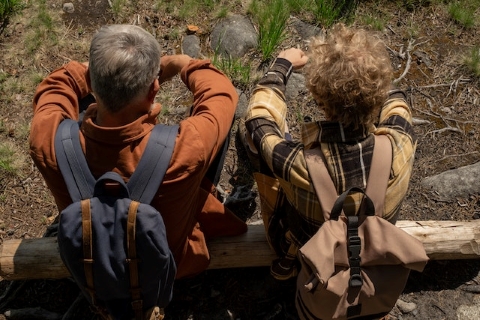How often do you go on lengthy treks that involve camping and backpacking? Or maybe carry a backpack for your belongings as you hop from destination to destination? If so, you understand the value of a well-designed backpack. It doesn’t matter how well thought out or equipped your backpack is if it doesn’t fit you properly. It’s just not going to be pleasant. Discomfort, pain, and even harm can result from a backpack that is either improperly fitted or made.
The straps on your backpack are a crucial feature because they help disperse the load you’re carrying across your shoulders and back. The good news is that there are a number of approaches to enhancing the comfort of backpack straps. So that you can enjoy your outdoor or international travels without any pain, we will cover how to make backpack straps more comfortable, including adjusting the straps and adding additional cushioning.
Table of Contents
Why Does My Backpack Hurt My Shoulders?
There could be multiple reasons why one might be experiencing pain or stress on the shoulders while wearing a backpack. A very common explanation behind shoulder pain is the one-strap sling method of carrying a backpack. Though it is a very in-style way of carrying around a bag, it is also very detrimental to your posture and shoulder. Not only will the pressure of the whole bag on one shoulder cause pain on that shoulder and on your back, but the strap will also chafe at your skin without proper, stable support.
This uneven weight distribution could potentially cause lifelong problems to your back, neck, and shoulders, which is one of the reasons backpacks are preferred over messenger bags for carrying heavier loads over a long period of time..
Another thing to keep in mind about your straps is the material they are made from. Depending on this, your skin could become chafed and sensitive over time, or it could be in perfect condition without any roughness or pain. While it is not hard to find backpacks with padded straps, many do not have sufficient padding or do not use the right type of material, which can be very detrimental as well.
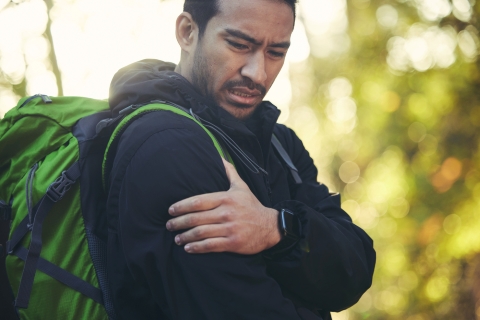
Backpacks are also generally worn hanging very low on the back. This method of carrying a bag puts much pressure on your shoulders and may also cause you to lean forward to better balance the weight of your bag. This lean often causes discomfort and lower back pain over time.
There are also many times when people might find themselves experiencing shoulder pain solely due to the load of their bags. While you could have a backpack that can hold a hundred and one things, it’s generally not advised to hold so many items, as the weight of the bag, even if it is well distributed and strapped onto both shoulders, can just be too much for your back and shoulders to handle especially for a long duration of time. If you do intend on going hiking, however, then it might be beneficial to exercise your shoulder and lower back muscles in advance. This will help strengthen your body to endure more weight than usual.
What Are Backpack Straps Made Of?
There are 3 commonly used materials for backpack shoulder straps. Two of them, nylon and polyester, are also used commonly to make the body of backpacks. Most bags have straps made from nylon webbing along with foam padding, which has many benefits. These straps are strong, inexpensive, and won’t stretch out much even with excessive use, and the synthetic material used is also highly water-resistant, making the straps very durable for multiple weather conditions. Any water absorption there may be, be it rain or sweat, will quickly dry out. However, this quick-dry benefit can also be a drawback for some people, due to the retention of odor and bacteria build-up within the straps.
Some high-end backpacks, particularly those used for heavy-duty weight-carrying for hiking and other activities, are made from Dyneema webbing. This is a lighter and stronger material than nylon, but in turn, makes the bag much more expensive than a nylon-based bag. But if you want a backpack with highly durable straps that are more water-resistant than any other type available on the market, then you should go for one with Dyneema-based straps.
Polyester straps are the third most commonly found straps on backpacks. While this material makes for very durable and wrinkle-resistant straps, there are many drawbacks to make note of before you buy a polyester-strapped bag. They may be quite inexpensive, but these straps are also known not to be very breathable and often retains much odor, requiring you to wash the bag more frequently than others. Probably the drawback you should be concerned about the most is the static build-up, which can make it quite uncomfortable to wear, and is especially not recommended to use when going on multi-day trips that require you to be on your feet for a long time. These straps could also make your shoulders sore after hiking if you carry a heavy load.
How to Relieve Shoulder Pain From Backpack
There are many reasons why you might be facing stress or pain on your shoulders due to your backpack, and there are certainly ways to eradicate such pain. In many cases, shoulder pain is completely preventable. But there are multiple things to keep in mind right from when you’re looking to buy a backpack.

Get the Right Size Backpack With the Right Fit
Backpacks come in various sizes, with many of them being adjustable and some only coming tailored to fit one torso and waist size. While most people generally buy a backpack by just looking at the compartments and eyeing the size, it’s very important that you measure your torso before buying one.
There will usually be 3 different sizes a backpack will be offered in; small, medium, and large fit. They are mainly separated concerning the length of the torso but some are further classified as being for men or women. The pack should also ideally be hanging till your waist and not even an inch more below. If you use a bag that is longer than the length of your torso, adjusting the shoulder straps may cause a pinch at your shoulders, causing discomfort. This is where you can prevent potential shoulder and back pain you might face in the future. It’s not just about how the bag sits on your back, but also about the additional straps and their lengths included with most backpacks. More on this later.
No matter your waist or torso size, there will always be a backpack that’s right for you. But you should also take into consideration the main purpose of the backpack so that you gain further clarity of the size required. Is it going to be used for hiking or as a carry on for travel? There are backpacks made for every purpose, and so, the size and weight of the bags will also vary.
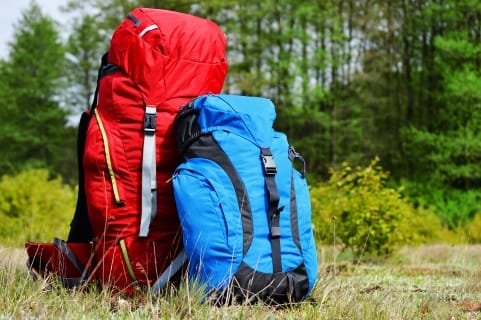
Proper Packing Backpack Weight Distribution
Carrying a heavy load on your shoulders is fine and a very common thing for everybody, from school-going children to backpackers. However, the distribution of your belongings with respect to the space in your bag is something to keep in mind. The bag shouldn’t be lopsided. If you’re going on a hike, for example, there will certainly be a few large items in or attached outside your pack, like a sleeping bag for example. You can learn the methods to attach your sleeping bag to your backpack.
It’s important to compartmentalize properly and make sure that all heavy items sit in the middle of the bag for most backpacks. This will not only help in keeping your posture right but also in keeping the shape of your bag without having any objects leaning heavily to the sides of the compartments. Without keeping an even distribution of weight in your backpack, you could end up using the muscles of one side of your body far more than the other.
The weight of a fully loaded backpack is also a major deciding factor in the comfort of carrying a bag. Usually, people stuff their bags as much as they can when they go on multi-day trips. But this can be very detrimental to their body posture and shoulder. For a multi-day trip and hike, your backpack shouldn’t weigh more than 20% of your body weight, as you’ll be exerting your body quite a bit on top of being on your feet constantly. In general, when carrying a pack, the ideal weight of it should not exceed 10% of your body weight. But ultimately, only you can be the judge of what you can or can’t hold on your shoulders.
Make Sure You Know How to Adjust Backpack Straps
One of the bigger ways to prevent shoulder pain and stress to your body overall is by adjusting your backpack’s straps. There are multiple straps to help keep the bag safely latched onto your body while also keeping it comfortable to wear. While not all backpacks come with the same types of straps (sternum belt, load lifters, etc,), it’s important to know how to adjust them for better pack fitting.
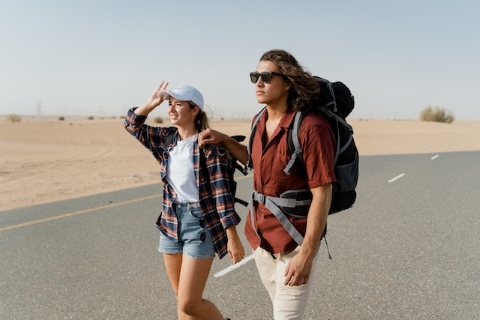
Waist straps
The waist belt can greatly help position your pack in the right spot so that your hips bear most of the load of the bag instead of your shoulders and back. It should be well buckled right above your hips and tight enough not to have it slide down. First, wear the bag. Then, buckle the belt around your waist. There are 2 strap extensions located on both sides of the hip belt that when pulled together, will decrease the space between your back and the bag. The straps can also be loosened to accommodate more space by pulling on the other sides of the strap extensions under the tri-glide strap slide loops. There should ideally be no space between your back and the bag for a good, comfortable fitting.
Load lifters
Another pair of straps that are very important to tighten are the load lifters, located at the top of the bag. These straps are only found on larger backpacks meant for hiking and trekking. These bags are usually built to hold a large number of things and usually end up being quite heavy. To adjust them well, first, wear the bag. You will see 2 dangling straps located above your shoulders, connecting your shoulder straps to your bag. Pull them both in front and away from you to bring the weight of the bag closer to your core and center of gravity. This will spare the front of your shoulders from being chafed and pulled.
Sternum strap
The chest or sternum strap helps pull the shoulder straps together, keeping them from sliding off your shoulders and keeping the pack stabilized as you walk. The weight of the bag is also centered even further by fastening the sternum belt, taking more pressure off your shoulders. While wearing the bag, buckle the sternum strap onto your chest. It should generally be sitting an inch below your collar bone. It may be loose at first, but can be easily tightened by pulling the dangling strap extension away from you until it fits you comfortably.
Shoulder straps
Lastly, the most important one on any backpack, your shoulder straps should neither be too tight nor too loose. They need to hold the bag up and never let it sag, to prevent your shoulders from doing the heavy lifting. To adjust them, pull down on the 2 hanging strap extensions at the bottom evenly. This will help bring the backpack up to the right level on your back. They shouldn’t be so restrictive to the point where it’s hard to take the bag off your body. In the end, always remember to focus on comfort more than anything else, as this will save you from shoulder and back stress in the long run.
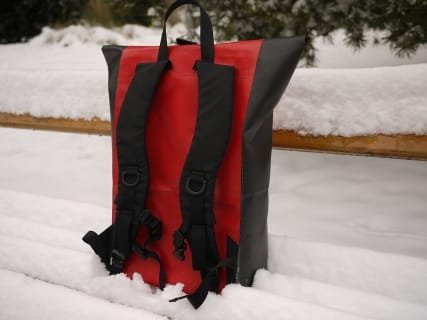
Learn How to Add Padding to Backpack Straps
Having well-padded backpack straps is very necessary for any bag and any activity to reduce chafing and pressure on the shoulder muscles. There are 2 ways by which you can add padding to your backpack straps if they’re not already well-padded.
The first and easiest way to add padding is by simply purchasing replacement shoulder pads. These can be used as shoulder strap pad add-ons and can be fixed onto your straps with ease. These are usually made with quality memory foam to gently cushion whatever body part it presses onto. It’s also easy to attach and detach using its velcro seal. If you want a quick solution to your uncomfortable backpack straps that is breathable and maintains its cushion effect, then you should buy these handy, inexpensive strap pads.
The second way to add padding requires effort on your part. This is a DIY method of making your shoulder straps more comfortable by attaching fleece tubes onto your straps. To make the fleece tubes, follow these steps carefully:
First, measure the distance from the sternum buckle to the top of your shoulder strap. Next, measure the circumference of the strap and add an extra half-inch to your measurement for a seam entry. Once you’ve got the right measurements, cut out a rectangular piece of the fabric that is measured by length into breadth using your measurements. Fold the rectangular piece of fabric lengthwise and stitch the edges together leaving a 1/4″ seam entry space. Now that you have your fleece tube ready, slide the fleece tube onto your shoulder strap and reattach the strap to the webbing. You could also turn the tube inside out for a cleaner, smoother look without showing unfinished edges.
It may take a little time to do this for both straps, but it is effective in the end. However, there are a few drawbacks to this method. Some may not find fleece very suitable as backpack strap padding material due to it being very dense and not breathable, collecting dust, and losing its cushion over time.
FAQs
EVA foam is commonly used in padding backpack shoulder straps due to its springiness and durability. Closed-cell foam and open-cell foam are also commonly used as backpack strap padding. However, closed-cell foam padding is much more preferred than open-cell due to its ability to retain its cushion and form even after much use carrying heavy loads.
Generally, a backpack should be well-fastened to the body to make sure that the bag or any of its items won’t fall out. This, along with comfort, determines how tight backpack straps should be.
If your backpack straps didn’t already come padded or the padding isn’t sufficient enough, then you can purchase strap pads online that are easy to attach to your straps. There are also a few DIY methods such as making slide-on fleece tubes or placing some cloth under the straps, though the latter is a temporary solution.

